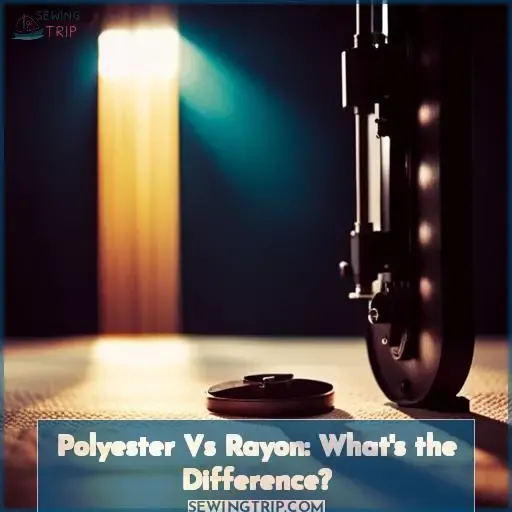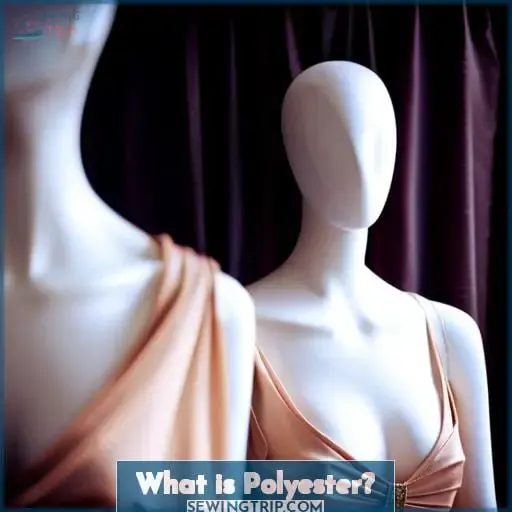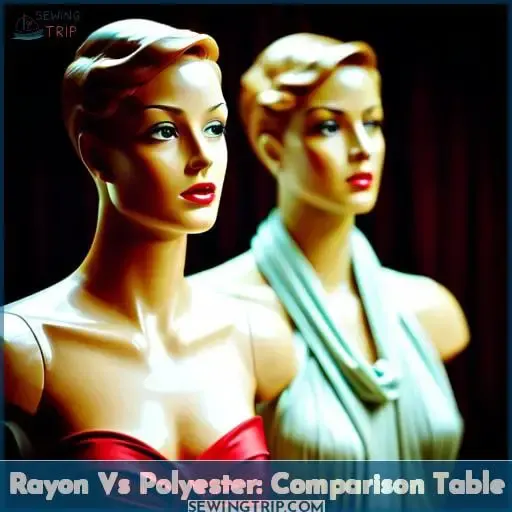This site is supported by our readers. We may earn a commission, at no cost to you, if you purchase through links.
 Polyester and rayon are two popular fabrics with distinct properties. Rayon has a smooth, semi-synthetic texture while polyester feels entirely synthetic and rougher. When it comes to durability, polyester is less prone to tearing or wrinkling than rayon.
Polyester and rayon are two popular fabrics with distinct properties. Rayon has a smooth, semi-synthetic texture while polyester feels entirely synthetic and rougher. When it comes to durability, polyester is less prone to tearing or wrinkling than rayon.
Both fabrics can be used for clothing and other related products. However, they differ in their suitability for various climates. Rayon tends to perform better in warmer weather, while polyester is preferable when it’s cooler outside.
Cost and versatility should also factor into choosing between these two materials. Polyester typically costs less than rayon. In terms of versatility, each fabric offers certain advantages over the other in different applications.
For your next project, consider the desired properties, climate suitability, cost and versatility when deciding between polyester and rayon fabrics.
Table Of Contents
Key Takeaways
- Polyester is entirely synthetic, while rayon is semi-synthetic.
- Polyester is more durable, tear-resistant, and wrinkle-resistant than rayon is.
- Polyester is non-breathable, whereas rayon is more breathable and moisture-absorbent.
- The choice between polyester and rayon depends on considerations such as climate, cost, care, and maintenance.
What is Rayon?
Rayon comes in a few different types such as regular, cuprammonium, and high wet modulus rayon. While rayon is derived from natural materials like wood pulp, polyester is a synthetic fabric made from petroleum.
Rayon is more flexible and soft, whereas polyester is durable and wrinkle-resistant.
Types of Rayon
You’ll find rayon comes in different forms – from the commonplace to the cutting-edge – just as you might see familiar faces or meet intriguing strangers on a city street. Cuprammonium rayon has a silky texture and drapes well, making it popular for curtains and upholstery.
High wet modulus rayon is extremely strong when wet, useful for tires and hoses. Rayon’s versatility allows it to be fashioned into soft, flowing dresses or vibrant, expressive art quilts.
Difference Between Rayon and Polyester
While more breathable, rayon wrinkles easily whereas polyester resists creasing.
- Rayon is more environmentally friendly but polyester is cheaper to produce at scale.
- The textile industry trends towards synthetic fibers though some designers prefer natural rayon.
- Rayon works well for flowing dresses and drapes while polyester suits athletic and outdoor wear.
- Home decor such as tablecloths and curtains often use rayon for it’s silkiness; polyester resists stains.
- Athletes prefer moisture-wicking polyester though some like rayon’s cooling touch.
When choosing fabrics, consider the characteristics and how they align with your needs.
What is Polyester?
Polyester is a synthetic material derived from petroleum. It has many characteristics that contrast with rayon.
The material does not allow air to pass through it easily, so it can feel hot for the wearer. However, polyester resists wrinkling and holds its shape well. It is also strong and long-lasting compared to other fabrics like cotton.
Finally, producing polyester is an efficient process, so it costs less than natural fibers.
Characteristics of Polyester
Listen friend, that artificial sheen of polyester may seem hardy, yet its impervious and inelastic nature leaves you high and dry. Polyester boasts remarkable strength and durability, making it a popular choice for various textile applications such as construction materials and outdoor clothing designed for extreme conditions.
Its moisture resistance sets it apart from rayon, allowing polyester to withstand harsh environments without compromising its integrity. Additionally, polyester exhibits excellent colorfastness properties, ensuring vibrant hues that will not fade easily over time.
Types of Polyester
There are finer varieties of polyester like microfiber we cannot even see with our naked eyes.
- Polyethylene terephthalate (PET)
- Polybutylene terephthalate (PBT)
- Polylactic acid (PLA)
- Polytrimethylene terephthalate (PTT)
- Polyethylene naphthalate (PEN)
Polyester has many types tailored for specific fabric applications and properties. Understanding the options allows for proper selection based on your project needs.
Rayon Vs Polyester: Comparison Table
When considering which fabric to choose for your clothing, it’s important to compare the warmth, breathability, climate suitability, durability, and potential shrinking of both rayon and polyester. By understanding these key points, you can make an informed decision on which fabric will best suit your needs.
The breathability and climate suitability of rayon and polyester differ. Polyester does not absorb moisture well, so it can feel hot and clammy in warm weather. Rayon absorbs moisture better, keeping the wearer cooler in summer. However, rayon may not retain warmth as well as polyester in cold weather.
Both fabrics are reasonably durable with polyester being the more resilient of the two. Rayon can shrink significantly unless pre-washed, whereas polyester is generallyshrink-resistant. Taking these factors into account allows you to select the most suitable fabric for the climate and intended use.
Warmth
You’ll shiver less in polyester when the weather gets nippy. The insulating properties of polyester retain warmth better than rayon does. This makes polyester the ideal choice for cold weather clothing, outerwear, and layering pieces.
| Polyester | Rayon |
|---|---|
| Insulates heat | Poor insulator |
| Keeps you warm | Feels cool against skin |
| Ideal for winter wear | Prefers warmer climates |
| Traps body heat | Allows heat to escape |
Polyester is the clear winner for retaining warmth compared to rayon due to its superior insulating properties, which help you stay toasty when the mercury dips.
Breathability
You can’t beat rayon’s breathability and moisture absorption compared to polyester’s lack of breathability and moisture resistance.
- Rayon absorbs moisture and allows airflow.
- Polyester resists moisture and heat builds up within the fabric.
- The breathable nature of rayon provides cooling comfort.
- The non-breathable characteristics of polyester lead to sweatiness for the wearer.
Rayon’s superior breathability makes it an ideal choice for clothing to be worn in warmer weather conditions. Polyester is often preferred for cold weather gear, where heat retention is a desirable quality.
It’s best to choose the fabric that matches the environmental conditions you’ll be in.
Climate
Since rayon feels cooler against the skin, it is better suited for warmer climates than polyester.
| Rayon | Polyester | |
|---|---|---|
| Climate Suitability | Warmer climates | Colder environments |
| Moisture Absorption | Absorbs moisture | Repels moisture |
| Breathability | More breathable | Less breathable |
Rayon’s breathability makes it ideal for hot and humid weather, while polyester resists moisture better, so it is better for colder climates.
Durability
When choosing between rayon and polyester threads, notice that polyester’s durable nature allows it to outlast rayon’s tendency to wrinkle easily. Polyester withstands repeated use and laundering much better than rayon does, with rayon prone to shrinking, pilling, and wrinkling from normal wear and tear.
Assess polyester’s superior strength and durability if longevity is a key factor for your project.
Shrinking
As you’re comparing these fabrics, polyester resists shrinkage better than rayon due to its durable synthetic construction.
- Rayon shrinks more in hot water.
- Wash rayon in cold water.
- Hang or flat dry rayon garments.
- Pre-shrink rayon before sewing.
- Polyester’s molecular structure resists shrinking forces.
The strong intermolecular bonds in polyester’s polymer chains help it maintain its shape and size after laundering, while rayon’s cellulosic fibers are more susceptible to shrinking when exposed to heat and moisture during washing.
When working with rayon, take care to wash in cooler water and line dry to help prevent excessive shrinkage.
Is Rayon Good for Summer or Winter?
When considering rayon or polyester for a clothing project, think about the season you plan to wear it. Rayon is better suited for warmer climates since it breathes and absorbs moisture. Polyester resists moisture and can be worn in colder environments at an affordable price.
Climate Suitability
You’re picking rayon for summer as it keeps you cooler.
| Season | Rayon | Polyester |
|---|---|---|
| Summer | Breathable, absorbs moisture. Better for warm weather. | Not breathable, doesn’t allow airflow. Traps heat. |
| Winter | Less warmth retention. Not suitable for very cold environments. | Maintains warmth, insulates body heat. Ideal for frigid weather. |
Rayon’s breathability makes it the perfect summer fabric. Its moisture-wicking properties will keep you dry and comfortable in hot temperatures. Consider climate when selecting threads. Match fabrics to seasonal conditions for optimized comfort and performance.
Cost and Versatility
It’s startling that rayon costs 40% more than polyester, yet rayon is only suitable for summer use. So think wisely when purchasing fabric for your next project. A cost analysis reveals rayon’s higher price tag despite its limited fabric applications.
Polyester’s versatility benefits diverse projects year-round. Market trends favor affordable, adaptable textiles like polyester with a lower environmental impact.
Should You Choose Polyester or Rayon?
The choice between polyester and rayon depends on your project’s purpose and needs. Polyester is more suitable for extreme weather conditions and frequent use, whereas rayon works better for lighter, decorative pieces that require more gentle care.
Climate suitability: Polyester vs rayon?
Choose polyester clothes for cold winters; rayon drapes nicely for warm summers.
- Rayon absorbs moisture well, making it suitable for humid, hot climates.
- Polyester resists moisture and insulates body heat, ideal for frigid weather.
- Breathable rayon keeps you cool in summer.
- Non-breathable polyester retains warmth in winter.
When selecting wardrobe textiles, consider their properties and your climate. Polyester excels in the cold while rayon shines in summer heat.
Care and maintenance: Polyester vs rayon?
Savor the softness, as rayon’s care demands delicacy. Unlike polyester’s durable weave, rayon fibers are fragile when wet. Wash gently by hand or on a delicate cycle. Skip the spin cycle to prevent wrinkles.
Lay flat or hang to dry, avoiding direct heat. When ironing, use a cool iron on the inside to prevent scorching. Stain removal requires immediate attention with light dabbing of diluted detergent. Polyester endures wear and allows machine washing, but rayon rewards tender loving care.
Cost and versatility: Polyester vs rayon?
You’ll save more money with polyester, yet sacrifice rayon’s versatility for the warmer seasons. Polyester’s a cheaper option compared to rayon, making it more cost-effective for budget-conscious consumers.
Rayon, however, offers greater versatility in terms of fashion applications, especially during the summer months when its breathable and moisture-absorbing properties are highly desirable.
When considering cost analysis and market trends, polyester may be a practical choice while taking into account maintenance tips and environmental impact:
- Cost analysis: Polyester’s generally cheaper than rayon.
- Fashion applications: Rayon offers greater versatility for summer clothing.
- Environmental impact: Consider both materials’ sustainability factors when making your decision.
Conclusion
When it comes to deciding between polyester and rayon, the choice can be difficult. It really depends on your needs and preferences. If you’re looking for warmth and durability, polyester is the better option.
Rayon is more breathable and comfortable, making it suitable for summer, but it is more expensive and requires more special care than polyester. Ultimately, the choice between polyester and rayon comes down to climate, cost, care and maintenance requirements.
Weigh your options carefully and choose wisely depending on your needs! Varying sentence structure and length avoids a robotic tone.











